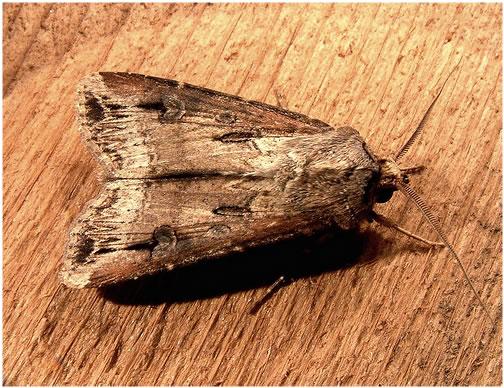Crop Protection :: Pest of sarpagandha
Insect pests of sarpagandha
 |
Crop: Sarpagandha
S.N: Rauvolfia Serpentina
Family: Apocynaceae
Pests |
Important pests of sarpagandha
Top
1. Cut worm, Agrotis sp.
Symptom of damage
- Larva attack the tender seedlings
- Caterpillars are nocturnal in habit and found under debris around plants.
- Cuts seedlings near the ground level and eat the tender parts.
- Damage is more in low lying water logged areas.
Top
Identification of the pest
- Eggs are globular in shape, ribbed and whitish in color.
- Tiny caterpillars feed gregariously on the foliage for a few days and then enter in to the soil.
 |
 |
Larva |
Adult |
Management
- Fork the soil (summer months) – to expose larva and pupa for avian predators
- Install light traps (summer) to attract adult moths
- Install Pheromone traps at 20/ha to monitor and attract male moths
- Irrigate the field in day time to expose larva for predation by birds.
- Drench collar region of the plants in evening hours with Chlorpyriphos 2ml/lit.a day after planting
Top
2. Sphingid caterpillar, Deilephila nerii
Symptom of damage
- Caterpillar feed on the leaves
- Defoliation
 |
 |
Identification of the pest
- Larva is stout with a spine in the anal region.
- Adult is robust green moth with yellow markings.
|
Larva |
Adult |
Top
Management
- Soil digging to expose the pupae for predation by birds
- Handpicking and destruction of caterpillars.
- Use light trap 1/ha
- Plant neerium around the bunds and take up plant protection on neerium with chemicals
Top
3. Epilachna beetle, Henosepilachna vigintioctopunctata
![1435025[1]](http://agritech.tnau.ac.in/crop_protection/crop_prot_crop_insect_medi_Sarpagandha_clip_image010.jpg) |
Symptom of damage
- Grubs and adults feed by scrapping chlorophyll from epidermal layers of leaves
- Skeletnized and gradually dry away.
|
Egg, Grub,Pupa and Adult |
Identification of the pest
- Grubs - yellowish in colour, stout with spines all over the body.
- Adult - spherical bluish brown and mottled with black spots.
Top
Management
- Collect and destroy grubs and adults.
- Spray carbaryl 50 WP 3g/lt + wettable sulphur2g/lt.
Top
4. Ash weevil, Myllocerus viridanus
 |
Symptom of damage
- Adults feeding on the leaves from the edges in a serrated manner
- Notching of leaf margins.
- Grubs feed on roots and cause wilting and drying of plants.
|
Adult, Ash weevil |
Top
 |
Identification of the pest
- Adult is small light green in colour.
|
Management
- Collection and destruction of adults
- Spraying of Carbaryl 0.2% or Malathion 0.1%
- Incorporation of soil with dust or drenching of the soil with 0.1% Chlorpyriphos
Top
5. Mealy bug, Coccidohystrix insolita
Symptom of damage
- Nymphs and adults present on undersurface of leaves and suck the sap
- Affected plants turn yellow, wilt and dry
- Honeydew secretion causes sooty mould.
![pWolluis[1]](http://agritech.tnau.ac.in/crop_protection/crop_prot_crop_insect_medi_Sarpagandha_clip_image016.jpg) |
Identification of the pest
- Mealy bugs are small, oval, and soft-bodied covered with white mealy wax.
|
Management
- Removal of affected parts in the early stage of attack.
- Spray application of dimethoate 0.05 % (or) methyldemeton 25 EC 0.05% (or) malathion 50 EC 0.1%
- Field release of coccinellid predators
- In the later stage of the crop neem oil 5ml or fish oil rosin soap 25 gm per litre of water can be sprayed
Top
Source
|
|




![1435025[1]](http://agritech.tnau.ac.in/crop_protection/crop_prot_crop_insect_medi_Sarpagandha_clip_image010.jpg)


![pWolluis[1]](http://agritech.tnau.ac.in/crop_protection/crop_prot_crop_insect_medi_Sarpagandha_clip_image016.jpg)